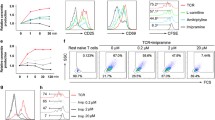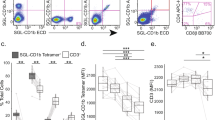Abstract
Previous studies have indicated that globotriaosyl ceramide (Gb3 or CD77) plays a role in α-interferon signal transduction and CD19-mediated homotypic adhesion in B cell lines derived from Burkitt's lymphoma. These roles for Gb3 may involve the proteins IFNAR-1 (subunit 1 of the interferon-α receptor) and CD19, respectively, both of which have potential Gb3-binding sites in their extracellular domains which resemble those of the verotoxin (Shiga toxin and Shiga-like toxin) B subunit. The majority of this work was performed using wild-type Daudi cells and a single, Gb3-deficient mutant cell line, VT500. In the present investigations, these and additional Daudi-derived cells with varying degrees of sensitivity to interferon-α were examined for Gb3 expression, interferon-induced growth inhibition and CD19 expression. The degree of interferon-induced growth inhibition and CD19 expression correlated with Gb3 expression in the various cell lines tested. In addition, reconstitution of the VT500 cell line with Gb3 but not other glycolipids partially restored the sensitivity of cells to IFN-induced growth inhibition. The degree to which reconstitution restored sensitivity to growth inhibition was similar to the results of previous studies in which Gb3 reconstitution restored sensitivity to verotoxin-induced cytotoxicity. These results demonstrate that Gb3 is specifically required for IFN-induced growth inhibition in Daudi cells and provide further evidence of a role for Gb3 in CD19 expression and function in these cells.
Similar content being viewed by others
References
Balana A, Wiels J, Tetaud C, Mishal Z, Tursz T, Induction of cell differentiation in Burkitt lymphoma lines. BLA: a glycolipid marker of B-cell differentiation, Int J Cancer 36, 453-60 (1985).
Gregory CD, Tursz T, Edwards CF, Tetaud C, Talbot M, Caillou B, Rickinson AB, Lipinski M, Identification of a subset of normal B cells with a Burkitt's lymphoma (BL)-like phenotype, J Immunol 139, 313-8 (1987).
Murray LJ, Habeshaw JA, Wiels J, Greaves MF, Expression of Burkitt lymphoma-associated antigen (defined by the monoclonal antibody 38.13) on both normal and malignant germinal-centre B cells, Int J Cancer 36, 561-5 (1985).
Nudelman E, Kannagi R, Hakomori S, Parsons M, Lipinski M, Wiels J, Fellows M, Tursz T, A glycolipid antigen associated with Burkitt lymphoma defined by a monoclonal antibody, Science 220, 509 (1983).
Gregory GD, Edwards CF, Milner A, Wiels J, Lipinski M, Rowe M, Tursz T, Rickinson AB, Isolation of a normal B cell subset with a Burkitt-like phenotype and transformation in vitro with Epstein-Barr virus, Int J Cancer 42, 213-20 (1988).
Lingwood CA, Yiu SCK, Glycolipid modification of a-interferon binding: sequence similarity between a-interferon receptor and the verotoxin (Shiga-like toxin) B-subunit, Biochem J 283, 25-6 (1992).
Ghislain J, Lingwood C, Fish E, Evidence for glycosphingolipid modification of the Type-I-interferon receptor, Journal of Immunology 153, 3655-63 (1994).
Khine A, Lingwood C, Functional significance of globotriaosyl ceramide in interferon-alpha 2/type I interferon receptormediated antiviral activity, J Cell Phys 182, 97-108 (2000).
Maloney MD, Lingwood CA, CD19 has a potential CD77 (globotriaosyl ceramide)-binding site with sequence similarity to verotoxin B-subunits: Implications of molecular mimicry for B cell adhesion and enterohemorrhagic Escherichia coli pathogenesis, J Exp Med 180, 191-201 (1994).
Taga S, Carlier K, Mishal Z, Capoulade C, Mangeney M, Lecluse Y, Coulaud D, Tetaud C, Pritchard L, Tursz T, Wiels J, Intracellular signaling events in CD77-mediated apoptosis of Burkitt's lymphoma cells, Blood 90, 2757-67 (1997).
Mangeney M, Lingwood CA, Caillou B, Taga S, Tursz T, Wiels J, Apoptosis induced in Burkitt's lymphoma cells via Gb3/CD77, a glycolipid antigen, Cancer Res 53, 5314-9 (1993).
Khine A, Firtel M, Lingwood C, CD77-dependent retrograde transport of CD19 to the nuclear membrane: functional relationship between CD77 and CD19 during germinal center B cell apoptosis, Journal of Cell Physiology 176, 281-92 (1998).
Lingwood CA, Law H, Richardson S, Petric M, Brunton JL, DeGrandis S, Karmali M, Glycolipid binding of purified and recombinant Escherichia coli-produced verotoxin in vitro, J Biol Chem 262, 8834-9 (1987).
Lindberg AA, Brown JE, Stromberg N, Westling-Ryd M, Schultz JE, Karlsson K-A, Identification of the carbohydrate receptor for Shiga toxin produced by Shigella dysenteriae type 1, J Biol Chem 262, 1779-85 (1987).
Saxena SK, O'Brien AD, Ackerman EJ, Shiga toxin, Shiga-like toxin II variant, and ricin are all single-site RNA N-glycosidases of 28 S RNA when microinjected into Xenopus oocytes, J Biol Chem 264, 596-601 (1989).
Cohen A, Hannigan GE, Williams BRG, Lingwood CA, Roles of globotriosyl-and galabiosylceramide in verotoxin binding and high affinity interferon receptor, J Biol Chem 262, 17088-99 (1987).
Bradbury LE, Kansas GS, Levy S, Evans RL, Tedder TF, The CD19/CD21 signal transducing complex of human B lymphocytes includes the target of antiproliferative antibody-1 and Leu-13 molecules, J Immunol 149, 2841-50 (1992).
Li X, Carter RH, Convergence of CD19 and B cell antigen receptor signals at MEK1 and the ERK2 activation cascade, J Immunol 161, 5901-8 (1998).
Fearon DT, Carter RH, The CD19/CR2/TAPA-1 complex of B lymphocytes: linking natural to acquired immunity, Annu Rev Immunol 13, 127-49 (1995).
Fujimoto M, Poe JC, Jansen PJ, Sato S, Tedder T,F, CD19 amplifies B lymphocyte signal transduction by regulating Srcfamily protein tyrosine kinase activation, J Immunol 162, 7088-94 (1999).
Lingwood C, Role of verotoxin receptors in pathogenesis, Trends in Microbiology 4, 147-53 (1996).
Nyholm P, Two distinct binding sites for globotriaosyl ceramide on verotoxins, Chemistry and Biology 3, 263-75 (1996).
Ling H, Boodhoo A, Hazes B, Cummings MD, Armstrong GD, Brunton JL, Read RJ, Structure of the Shiga-like toxin I Bpentamer complexed with an analogue of its receptor Gb3, Biochemistry 37, 1777-88 (1998).
Meurs E, Hovanessian AG, Alpha-interferon inhibits the expression of heavy chain mu-messenger RNA in Daudi cells, EMBO 7, 1689-96 (1988).
Boyd B, Tyrrell G, Maloney M, Gyles C, Brunton J, Lingwood C, Alteration of the glycolipid binding specificity of the pig edema toxin from globotetraosyl to globotriaosyl ceramide alters in vivo tissue targeting and results in a VT1-like disease in pigs, J Exp Med 177, 1745-53 (1993).
Lingwood CA, Verotoxin-binding in human renal sections, Nephron 66, 21-8 (1994).
Waddell T, Cohen A, Lingwood CA, Induction of verotoxin sensitivity in receptor deficient cell lines using the receptor glycolipid globotriosyl ceramide, Proc Natl Acad Sci USA 87, 7898-901 (1990).
Maloney M, Thin-layer chromatography in bacteriology. In Practical Thin-layer Chromatography, edited by Fried B, Sherma J, (CRC Press, Boca Raton, 1996), pp.19-32.
Magnani JL, Smith DF, Ginsburg V, Detection of gangliosides that bind cholera toxin: direct binding of 125I-labeled toxin to thin-layer chromatograms, Anal Biochem 109, 399-402 (1980).
Butch AW, Nahm MH, Functional properties of human germinal center B cells, Cell Immunol 140, 331-44 (1992).
Kelsoe G, Life and death in germinal centers (redux), Immunity 4, 107-11 (1996).
Liu YJ, Arpin C, de Bouteiller O, Guret C, Banchereau J, Martinez-Valdez H, Lebecque S, Sequential triggering of apoptosis, somatic mutation and isotype switch during germinal center development, Semin Immunol 8, 169-77 (1996).
Choe J, Kim HS, Armitage RJ, Choi YS, The functional role of B cell antigen receptor stimulation and IL-4 in the generation of human memory B cells from germinal center B cells, J Immunol 159, 3757-66 (1997).
Horvath G, Serru V, Clay D, Billard M, Boucheix C, Rubinstein E, CD 19 is linked to the integrin-associated tetraspans CD9, CD81, and CD82, J Biol Chem 273, 30537-43 (1998).
Behr S, Schriever F, Engaging CD19 or target of an antiproliferative antibody 1 on human B lymphocytes induces binding of B cells to the interfollicular stroma of human tonsils via integrin alpha 4/beta 1 and fibronection, J Exp Med 182, 1191-9 (1995).
Kansas GS, Tedder TF, Transmembrane signals generated through MHC class II, CD19, CD20, CD39, and CD40 antigens induce LFA-1-dependent and independent adhesion in human B cells through a tyrosine kinase-dependent pathway, J Immunol 147, 4094-102 (1991).
Smith SH, Rigley KP, Callard RE, Activation of human B cells through the CD19 surface antigen results in homotypic adhesion by LFA-1-dependent and-independent mechanisms, Immunol 73, 293-7 (1991).
Lingwood CA, Glycolipids as receptors, Trends Lipid Res 1, 39-55 (1991).
Arab S, Lingwood CA, Intracellular targeting of the endoplasmic reticulum/nuclear envelope by retrograde transport may determine cell hypersensitivity to verotoxin via globotriaosyl ceramide fatty acid isoform traffic, J Cell Physiol 1998, 646-60 (1998).
Ligwood CA, Khine AA, Arab S, Globotriaosyl ceramide (Gb3) expression in human tumour cells: intracellular trafficking defines a new retrograde transport pathway from the cell surface to the nucleus, which correlates with sensitivity to verotoxin, Acta Biochim Pol 45, 351-9 (1998).
Mazur E, Richtsmeier W, South K, Alpha interferon: differential suppression of colony growth from human erythroid, myeloid, and megakaryocytic hematopoietic progenitor cells, J Interferon Res 6, 199-206 (1986).
Sandvig K, Garred O, van Helvoort A, van Meer G, van Deurs B, Importance of glycolipid synthesis for butyric acid-induced sensitization to Shiga toxin and intracellular sorting of toxin in A431 cells, Molecular Biology of the Cell 7, 1391-404 (1996).
Lingwood C, Yiu S, Glycolipid modification of a-interferon binding: Sequence similarity between a-interferon receptor and the verotoxin (Shiga-like toxin) B-subunit, Biochemistry Journal 283, 25-6 (1992).
Scarozza AM, Collins TJ, Evans SS, DNA synthesis in nuclei isolated from Daudi cells: a model to study the antiproliferative mechanisms of interferon-α, J Interferon Res 12, 35-42 (1992).
Pfeffer LM, Stebbing N, Donner DB, Cytoskeletal association of human a interferon-receptor complexes in interferon-sensitive and-resistant lymphoblastoid cells, Proc Natl Acad Sci USA 84, 3249-53 (1987).
Evans SS, Collea RP, Leasure JA, Lee DB, IFN-a induces homotypic adhesion and Leu-13 expression in human B lymphoid cells, J Immunol 150, 736-47 (1993).
Sandvig K, Garred O, Prydz K, Kozlov J, Hansen S, van Deurs B, Retrograde transport of endocytosed Shiga toxin to the endoplasmic reticulum, Nature 358, 510-2 (1992).
Katagiri YU, Mori T, Nakajima H, Katagiri C, Taguchi T, Takeda T, Kiyokawa N, Fujimoto J, Activation of Src family kinase Yes induced by Shiga toxin binding to globotriaosyl ceramide (Gb3/CD77) in low density, detergent-insoluble microdomains, J Biol Chem 274, 35278-82 (1999).
Meivar-Levy I, Futerman AH, Up-regulation of neutral glycosphingolipid synthesis upon long term inhibition of ceramide synthesis by fumonisin B1, J Biol Chem 274, 4607-12 (1999).
Iwabuchi K, Yamamura S, Prinetti A, Handa K, Hakomori S, GM3-enriched microdomain involved in cell adhesion and signal transduction through carbohydrate-carbohydrate interaction in mouse melanoma B16 cells, J Biol Chem 273, 9130-8 (1998).
Kurzchalia T, Parton R, Membrane microdomains and caveolae, Curr Opin Cell Biol 11, 424-31 (1999).
Maloney M, Lingwood C, Interaction of verotoxins with glycosphingolipids, Trends in Glycoscience and Glycotechnology 5, 23-31 (1993).
Lee RS, Tartour E, van der Bruggen P, Vantomme V, Joyeux I, Goud B, Fridman WH, Johannes L, Major histocompatibility complex class I presentation of exogenous soluble tumor antigen fused to the B-fragment of Shiga toxin, Eur J Immunol 28, 2726-37 (1998).
Futerman AH, Distinct roles for sphingolipids and glycosphingolipids at different stages of neuronal development, Acta Biochem Pol 45, 469-78 (1998).
Hakomori S-I, Bifunctional role of glycosphingolipids, J Biol Chem 265, 18713-6 (1990).
Cheng PC, Dykstra ML, Mitchell RN, Pierce SK, A role for lipid rafts in B cell antigen receptor signaling and antigen targeting, J Exp Med 190, 1549-60 (1999).
Ilangumaran S, Briol A, Hoessli DC, CD44 selectively associates with active Src family protein tyrosine kinases Lck and Fyn in glycosphingolipid-rich plasma membrane domains of human peripheral blood lymphocytes, Blood 91, 3901-8 (1998).
Author information
Authors and Affiliations
Rights and permissions
About this article
Cite this article
Maloney, M.D., Binnington-Boyd, B. & Lingwood, C.A. Globotriaosyl ceramide modulates interferon-α-induced growth inhibition and CD19 expression in Burkitt's lymphoma cells. Glycoconj J 16, 821–828 (1999). https://doi.org/10.1023/A:1007145420116
Issue Date:
DOI: https://doi.org/10.1023/A:1007145420116




